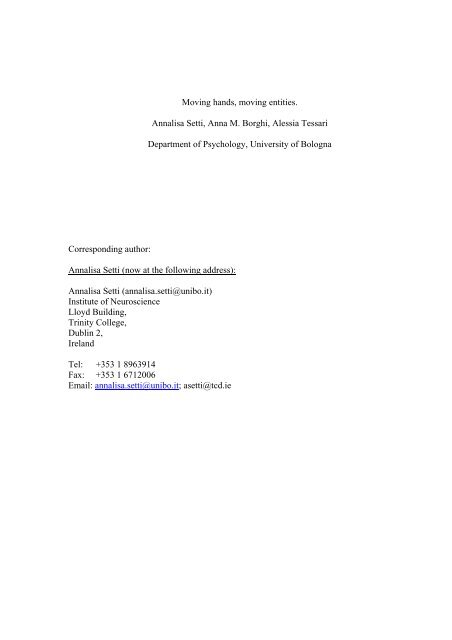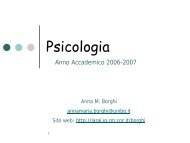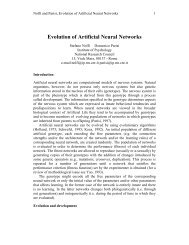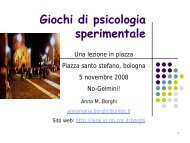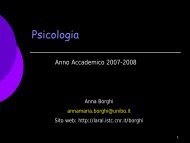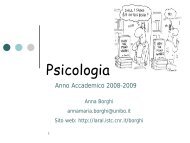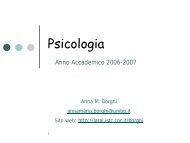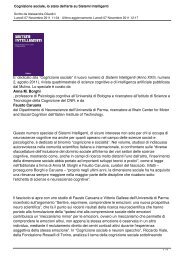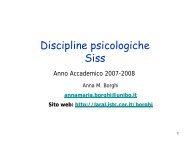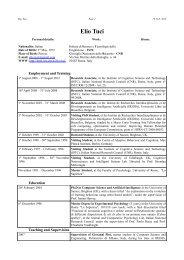Moving hands, moving entities. Annalisa Setti, Anna M ... - LARAL
Moving hands, moving entities. Annalisa Setti, Anna M ... - LARAL
Moving hands, moving entities. Annalisa Setti, Anna M ... - LARAL
Create successful ePaper yourself
Turn your PDF publications into a flip-book with our unique Google optimized e-Paper software.
Corresponding author:<br />
<strong>Moving</strong> <strong>hands</strong>, <strong>moving</strong> <strong>entities</strong>.<br />
<strong><strong>Anna</strong>lisa</strong> <strong>Setti</strong>, <strong>Anna</strong> M. Borghi, Alessia Tessari<br />
Department of Psychology, University of Bologna<br />
<strong><strong>Anna</strong>lisa</strong> <strong>Setti</strong> (now at the following address):<br />
<strong><strong>Anna</strong>lisa</strong> <strong>Setti</strong> (annalisa.setti@unibo.it)<br />
Institute of Neuroscience<br />
Lloyd Building,<br />
Trinity College,<br />
Dublin 2,<br />
Ireland<br />
Tel: +353 1 8963914<br />
Fax: +353 1 6712006<br />
Email: annalisa.setti@unibo.it; asetti@tcd.ie
Running head: <strong>Moving</strong> <strong>hands</strong>, <strong>moving</strong> <strong>entities</strong>.<br />
2
Acknowledgments – We would like to thank Audrey Vitale for running part of the<br />
subjects and Kate E. Burke for language revision. This work was supported by MIUR<br />
(Ministero Italiano dell’Istruzione, dell’UNiversita’ e della Ricerca), Progetto PRIN<br />
2006 to the first and second author and by the FP7 project ROSSI, Emergence of<br />
communication in RObots through Sensorimotor and Social Interaction, Grant<br />
agreement No: 216125 to the second and third author.<br />
3
Abstracts. In this study we investigated with a priming paradigm whether uni and<br />
bimanual actions presented as primes differently affected language processing.<br />
Animals’ (self-<strong>moving</strong> <strong>entities</strong>) and plants’ (not self<strong>moving</strong> <strong>entities</strong>) names were used<br />
as targets. As prime we used grasping <strong>hands</strong>, presented both as static images and<br />
videos. The results showed an interference effect with unimanual action primes (both<br />
static and <strong>moving</strong>) with plants’ names. No modulation of responses for animals’<br />
names was found. We argue that in the present task plants elicit information on<br />
unimanual grasping actions they support, while the lack of effect for animals could be<br />
due to them being better characterized as active agents.<br />
4
What happens in the mind when one sees someone grasping an animate or an<br />
inanimate object such as a hen or a melon? Does our brain “resonate” as if we were<br />
performing the action in question? More importantly, does motor resonance take into<br />
account that animate <strong>entities</strong> might move or try to escape while inanimate <strong>entities</strong> can<br />
not? Does language processing reflect this ‘resonance’? The present paper aims to<br />
investigate these issues, using a priming paradigm in which a hand-prime was<br />
followed by words referring to either animate or inanimate <strong>entities</strong>.<br />
A number of studies have shown that seeing an effector (e.g., hand)<br />
performing an action evokes a resonance mechanism. The neural underpinning of this<br />
echoing mechanism is known as the mirror neuron system (MNS). Research has<br />
shown that the MNS is activated when the subject performs a purposeful movement<br />
toward an object and when the same movement, executed by someone else, is<br />
observed (for a review, see Rizzolatti & Craighero, 2004). Behavioral studies with<br />
visuomotor priming paradigms provide evidence of this motor resonance mechanism.<br />
In particular, congruency effects have been found between the position and<br />
perspective of a given hand prime and the grasping hand final position, or the position<br />
and perspective of the hand target (Bruzzo, Borghi & Ghirlanda, 2008; Craighero,<br />
Bello, Fadiga & Rizzolatti, 2002; Vogt, Taylor & Hopkins, 2003).<br />
Further behavioural studies manipulate not only the type of hand prime, but<br />
also the pragmatic characteristics of the target-object being compatible or<br />
incompatible with the action depicted in the prime (e.g. Yoon & Humphreys, 2005).<br />
Overall, the mentioned studies do not allow determining whether a static image prime<br />
depicting a <strong>moving</strong> action is sufficient to evoke motor resonance, or whether a motor<br />
training is necessary. For example, in a categorization task Borghi, Bonfiglioli, Lugli,<br />
Ricciardelli, Rubichi & Nicoletti (2007) observed a congruency effect between the<br />
5
prime hand posture (power, precision) and the object size (large, small), but this<br />
occurred provided that participants received motor training, which required them to<br />
imitate the gestures displayed in the hand-pictures (see also Bazzarin, Borghi, Tessari<br />
& Nicoletti, 2007). The training might be necessary for participants to allow them to<br />
capture the static hand posture as a ‘snapshot’ of a <strong>moving</strong> grasping action, i.e. to<br />
enhance the implied motion evoked by the hand. Vainio, Symes, Ellis, Tucker &<br />
Ottoboni (2008) found similar congruency effects between a hand prime and a target<br />
object, but they presented videos instead of static images of the grasping hand. Fischer,<br />
Prinz and Lotz (2008) found that seeing different hand postures automatically directs<br />
attention towards congruent target objects, but they used hand postures the position of<br />
which varied dynamically over time. Whether or not the observation of a static<br />
depiction of a manual action is sufficient to activate the MNS remains unclear.<br />
Studies on implied motion have focused on the differences between observation of<br />
static or <strong>moving</strong> actions showing that static photographs characterised by implied motion<br />
(Freyd, 1983) activate brain regions involved in visual motion processing (Kourtzi &<br />
Kanwisher, 2000). In a recent fMRI study by Nelissen, Luppino, Vanduffel, Rizzolatti,<br />
& Orban (2005) monkeys viewed videos displaying human <strong>hands</strong> performing an action<br />
with or without an object. Videos with actions and motion of the object were compared<br />
with static photographs. Static images of mimicked actions did not show much activation<br />
on the mirror neurons areas or on Brodmann area 45, where information on objects and<br />
on action converges. However, activation did occur when videos were used. In contrast,<br />
in another fMRI study with humans Johnson-Frey, Maloof, Newman-Norlund, Farrer,<br />
Inati and Grafton (2003) showed that observing static pictures of the same objects being<br />
grasped or touched is sufficient to selectively activate the frontal mirror region. In a<br />
Transcranial Magnetic Resonance (TMS) study Urgesi, Moro, Candidi, Aglioti (2006)<br />
presented participants with static pictures of either a resting hand, a grasping hand in<br />
6
(implied) motion, or a hand adopting a final precision grip posture (always without<br />
objects). They found TMS gating effects over the primary motor area for the implied<br />
motion picture, but not for the start or end postures.<br />
To summarise, the reported behavioural studies leave the question unanswered,<br />
of whether the presentation of a static hand image is sufficient to activate motor<br />
resonance, or whether some kind of motor training or dynamic presentation of the<br />
hand is required. Similarly, but at a different level, the neural studies described above<br />
do not provide definitive clarification on whether the movement of an observed action is<br />
necessary to activate the mirror neuron system or whether implied motion in an image is<br />
sufficient<br />
At the same time, while a great deal of research has been dedicated to motor<br />
programs associated with different kinds of postures (e.g., precision vs. power grip),<br />
the difference between unimanual and bimanual grasping and its effect on target<br />
processing has not been investigated. However, this difference seems relevant on an<br />
ecological ground, as different kinds of objects are intuitively preferably associated<br />
with different actions, i.e. monomanual and bimanual. In particular <strong>moving</strong> <strong>entities</strong>,<br />
such as animals, are more associated with bimanual actions, i.e. one is more likely to<br />
grab a dog or a hen with two rather than one hand. Conversely unimanual actions<br />
seem to be more associated with static <strong>entities</strong>, e.g. vegetables and fruit (within the<br />
natural kinds).<br />
One of the aims of our study is to clarify the differences between the role<br />
played by dynamic and static hand primes and to investigate the different effects of<br />
unimanual and bimanual postures on processing of word targets. In line with the<br />
studies reviewed above we chose a priming paradigm with hand-primes and animate<br />
and inanimate entity names as targets. The primes were characterised by one or two<br />
7
<strong>hands</strong> either (1) <strong>moving</strong> with a grasping action, or (2) depicting a grasping action with<br />
implied motion, or (3) <strong>moving</strong> in a downward direction without performing an action.<br />
With this selection we aimed to assess whether a prime depicting a <strong>moving</strong> action is<br />
more effective than a static image or whether the implied motion (action) is sufficient<br />
to evoke motor resonance. The prime depicting only the motion (not the action) would<br />
constitute a baseline relative to the primes depicting an action. This would be used in<br />
order to assess the motor resonance induced by seeing the action.<br />
The second aim of our study is to investigate the effects of hand primes on word<br />
targets referring to animate and not inanimate <strong>entities</strong>. Up to now only a few studies<br />
have focused on action priming on word processing. For example, Lindemann,<br />
Stenneken, van Schie and Bekkering (2006) have shown in a go/no go task that<br />
preparing to execute an action (e.g. drinking from a cup) primes the processing of a<br />
related word (e.g. mouth) but not of an unrelated one (e.g. eye). In this study<br />
participants were asked to perform (or not to perform) the action depending on the<br />
characteristics of the target word (e.g. lexically correct word or ‘non word’). The<br />
performed action could be compatible with the final objective (endpoint) of the action<br />
(e.g. drinking – mouth /eye). Response times were faster in the compatible condition.<br />
However, in this study participants performed an action. It is not clear to what extent<br />
the observation of an action (not performing it) would also interacts with word<br />
processing (see also Zwaan & Taylor, 2006 on motor resonance in sentence<br />
processing). Besides some recent studies in our laboratory, to our knowledge the<br />
effects of hand priming on word processing have not yet been investigated. Borghi,<br />
Bonfiglioli, Lugli, Ricciardelli, Rubichi & Nicoletti (2005) used hand primes<br />
displaying either a precision or a power posture followed by words referring to<br />
objects graspable with a precision or a power grip. Borghi, Zotti and Oggianu (under<br />
8
eview) presented static and dynamic primes that were objects, <strong>hands</strong>, or <strong>hands</strong><br />
interacting with objects followed by target verbs. Participants were required to press a<br />
key if they thought the target-verb was concrete. The interaction prime was the<br />
fastest. In addition, when a video instead of a still hand image was displayed, RTs<br />
with the hand action were faster than with the object prime.<br />
Even if they do not use priming paradigms, several behavioral studies support<br />
the hypothesis that motor resonance occurs automatically during exposure to action-<br />
related words (nouns, verbs, adjectives) (for a review, see Barsalou, 2008). In<br />
addition, studies on language grounding have revealed sensitivity to motion<br />
information. Previous studies with recognition paradigms have shown that we<br />
mentally simulate the motion of an object implied by a verbal description, for<br />
example the motion implied by sentences such as “The car approached you”<br />
(Kaschak, Madden, Therriault, Yaxley, Aveyard, & Zwaan, 2004). However, as far as<br />
we know no research has explored the possibility that objects characterised by<br />
autonomous movement could activate different actions from objects characterised by<br />
non autonomous movement.<br />
If seeing a hand-prime evokes motor resonance, and if words activate<br />
information on their referents’ motion, we predict a different effect of uni- and<br />
bimanual primes on animate and inanimate <strong>entities</strong>. Namely, unimanual hand primes<br />
should affect processing of inanimate <strong>entities</strong>: these <strong>entities</strong> do not need to be grasped<br />
with both <strong>hands</strong>, because they do not move. On the contrary, bimanual primes should<br />
primarily influence processing of animate <strong>entities</strong>, provided that these <strong>entities</strong> elicit<br />
motor resonance related to action.<br />
Method<br />
9
Participants<br />
49 undergraduate students from the University of Bologna volunteered for this<br />
experiment without pay. All participants reported normal or corrected-to-normal<br />
vision and their first language was Italian. They were all right handed by self-report.<br />
Stimuli and Materials<br />
Stimuli consisted of 8 primes coupled with 32 targets. The primes were<br />
<strong>moving</strong> or static images, the targets were words, i.e. concept nouns. Four primes<br />
displayed one arm and hand either <strong>moving</strong> or static (unimanual primes), 4 other<br />
primes displayed two arms and <strong>hands</strong> either <strong>moving</strong> or static (bimanual primes). The<br />
primes were the following: unimanual ‘Action+Motion’ (video illustrating one arm<br />
<strong>moving</strong> downwards while the hand is performing a grasp); unimanual ‘Motion only’<br />
(video illustrating one arm <strong>moving</strong> downwards while the hand is closed in a fist);<br />
unimanual ‘Action only’ (static image representing one arm with the hand in grasp<br />
position); unimanual ‘Catch trial’ (video representing the ‘Action+Motion’ condition<br />
played in reverse); bimanual ‘Action+Motion’ (video representing two arms <strong>moving</strong><br />
downwards while the <strong>hands</strong> are performing a grasp); bimanual ‘Motion only’ (video<br />
representing two arms <strong>moving</strong> downwards while the <strong>hands</strong> are closed in a fist);<br />
bimanual ‘Action only’ (static image representing two arms with the hand in grasp<br />
position); bimanual ‘Catch trial’ (video representing the ‘Action+Motion’ condition<br />
played in reverse).<br />
All videos were recorded with a female actress <strong>moving</strong> the arm(s) on a blue<br />
background, with natural lighting. The upper arm (shoulders excluded), the lower<br />
arm(s) and hand(s) were at the centre of the display. The videos were recorded with a<br />
JVC high band digital video camera and edited with the software Adobe Premiere® in<br />
order to equate the duration (500 ms).<br />
10
The static stimuli were obtained by extracting a frame from the<br />
‘Action+Motion’ videos (either unimanual or bimanual) with the software Adobe<br />
Premiere®. The frame displaying the central part of the action, when the grasp was<br />
clearly recognisable, was chosen as static stimulus.<br />
Target words consisted of 16 names of plants (e.g. apple) and 16 names of<br />
animals (e.g. rabbit). The words in both categories (plants and animals) were taken<br />
from the Lotto, Dell’Acqua, Job (2001) database of Italian nouns and they were<br />
balanced regarding the number of syllables (t items= 0.8, n.s.), frequency (t items = 0.9,<br />
n.s.) and familiarity (t items = 0.13, n.s.).<br />
All targets referred to relatively small size objects that can be grasped.<br />
Design<br />
The experiment was based on a mixed design with the Type of Prime<br />
(unimanual or bimanual) as between participants variables, Condition<br />
(‘Action+Motion’; ‘Motion only’; ‘Action only’; ‘Catch trial’) and Type of Target<br />
(plants or animals) as within participants variables. The 8 types of primes were paired<br />
with the 32 targets (16 plants and 16 animals) leading to 256 prime-target couples<br />
(128 unimanual and 128 bimanual).<br />
Two different groups of participants took part in the experiment so that each<br />
participant saw only 128 items (32 targets x 4 primes -either unimanual or bimanual-).<br />
Thirty two prime-target couples (2 plants and 2 animals x 8 conditions) were built for<br />
the training phase. In one set primes were unimanual, in the other they were bimanual.<br />
Procedure<br />
11
Participants were first seated in front of a computer screen at a distance of<br />
approximatly 57 cm. They were informed that they would see an image followed by a<br />
word. They were asked to press a key on the keyboard with their right hand if the<br />
target word referred to an entity that moves by itself. Another key was pressed with<br />
the left hand by participants if the target word referred to an entity that is moved by<br />
others and does not moved independently. The correspondence between the key and<br />
kind of response (animate/inanimate) was counterbalanced. Participants were also<br />
required to refrain from responding if the target word was preceded by one (or two)<br />
arm(s) <strong>moving</strong> from the bottom of the screen towards the top (Catch Trial). A<br />
training phase (16 prime-target pairs in each group) preceded the test phase in order to<br />
familiarize participants with the task. Each item was composed by a fixation cross<br />
(700ms) followed by the prime (500ms) and by the target (displayed until a response<br />
was provided – timeout 700ms) (Figure 2). Feedback was provided after each<br />
response indicating whether the response was correct or incorrect along with the RT.<br />
Half of the participants was presented with uni-manual primes and the other half with<br />
bi-manual primes.<br />
___________________________________________________________<br />
Insert Figure 1 about here<br />
____________________________________________________________<br />
Results<br />
participants).<br />
Participants with an error rate higher than 15% were eliminated (3<br />
In order to account for anticipatory or unusually slow response times, response<br />
times (RTs) +/- 2.5 standard deviations from the grand mean were removed from each<br />
participant’s data set. This resulted in a removal of 4% of the data. Subsequently<br />
12
RTs of the correct (i.e. hit) trials only and errors were analysed. A 2 x 3 x 2 Analysis<br />
of Variance (ANOVA) was run on the RTs and errors with Type of Prime (uni- and<br />
bi-manual) as between participants’ factors and Condition and Type of Target as<br />
within participant factors. The analysis on RTs showed a significant interaction of the<br />
3 factors [F(2,88) = 5.15, MSe = 1823, p < 0.01] as well as significant interactions<br />
between Type of Prime x Condition [F(2,88) = 4.97, MSe = 3678, p < 0.01] and<br />
Condition x Type of Target [F(2,88) = 6.72, MSe = 12262, p < 0.01]. We will discuss<br />
only the three way interaction as it’s the most relevant on both statistical and<br />
theoretical grounds.<br />
A Post Hoc Newman-Keuls (p < 0.05) analysis was run on the Type of Prime<br />
x Condition x Type of Target interaction showing that, with a unimanual prime, plant<br />
targets were processed more slowly when preceded by a ‘Action+Motion’ prime<br />
relative to a ‘Motion only’ prime (M = 725ms; M = 690ms respectively) and in trend<br />
‘Action only’ prime (M = 681ms, p = 0.059). Plants targets paired with an<br />
‘Action+Motion’ prime were also processed more slowly than animal targets paired<br />
with an ‘Action only’ prime (M = 677ms).<br />
___________________________________________________________<br />
Insert Table 1 about here<br />
____________________________________________________________<br />
Considering the bimanual primes, targets referring to animals were processed<br />
faster when preceded by an ‘Action+Motion’ and a ‘Motion only’ prime (M = 644ms;<br />
M = 663ms) than when preceded by an ‘Action only’ prime (M = 704ms). No effect<br />
was found for plants with bi-manual primes.<br />
The analysis on errors (ANOVA with Type of Prime as between participants<br />
factor and Condition and Type of Target as within participants factors) also showed a<br />
13
three way significant interaction between the three factors [F(2,88) = 3.95, MSe =<br />
0.688, p < 0.05]. The interactions between Type of Prime and Condition [F(2,88) =<br />
10.03, MSe = 8.16, p < 0.001], Condition x Type of Target [F(2,88) = 11.86, MSe =<br />
8.16, p < 0.001] and Type of Prime x Type of Target [F(1,44) = 27.5, MSe = 17.75, p <<br />
0.001] were also significant. A Post Hoc Newman-Keuls (p < 0.05) analysis was run<br />
on the Type of Prime x Condition x Type of Target interaction showing that targets<br />
referring to plants paired with a ‘Action only’ unimanual primes and targets referring<br />
to animals paired with the ‘Action+Motion’ bimanual primes lead to the highest<br />
number of errors and differed from all other conditions, while not differing from each<br />
other (M = 1.95; M = 1.78, respectively).<br />
Comparing the results on RTs and accuracy for animal targets with bi-manual<br />
primes, a speed-accuracy trade-off appeared as animal targets paired with bimanual<br />
‘Action+Motion’ primes were responded to faster leading to a higher number of<br />
errors than in the other conditions. Therefore, a further analysis taking into account<br />
the speed-accuracy trade-off was deemed necessary.<br />
Response times were divided by the proportion of correct responses (Chan,<br />
Merrifield, & Spence, 2005; Townsend, & Ashby, 1978) and entered in an ANOVA<br />
with Type of Prime as a between participants factor and Condition and Type of Target<br />
as within participants factors (same as above). As in the previous analyses the three<br />
way interaction was significant [F(2,88) = 9.84, MSE = 1.17, p < 0.001]. The<br />
interactions between Type of Prime x Type of Target [F(1,44) = 4.98, MSe = 1.49, p <<br />
0.05] and Type of Target x Condition [F(2,88) = 3.87, MSe = 4.62, p < 0.05] were<br />
also significant. As above we will discuss only the three way interaction.<br />
The Post Hoc Newman-Keuls (p < 0.05) analysis ran on the Type of Prime x<br />
Condition x Type of Target interaction showed a significant difference between RTs<br />
14
for targets referring to plants when preceded both by ‘Motion+Action’ and ‘Action<br />
only’ primes compared to the ‘Motion only’ condition. Plants in the unimanual<br />
‘Motion+Action’ and ‘Action only’ condition also differed from animal targets in the<br />
unimanual ‘Action only’ condition. No significant difference was found when primes<br />
were bimanual. Figure 2 illustrates the normalised response times in both unimanual<br />
and bimanual conditions.<br />
___________________________________________________________<br />
Insert Figure 2 about here<br />
____________________________________________________________<br />
To summarise, once speed of processing and accuracy are taken into account<br />
in the analysis, only unimanual primes displaied a significantly affected target<br />
processing. Regarding the type of target, only information elicited by plants was<br />
significantly modulated by the prime.<br />
Primes representing an action, either static (‘Action only’) or dynamic<br />
(‘Action+Motion’) affected participants responses by increasing RTs to targets<br />
referring to plants relative to primes representing a movement non involving action,<br />
i.e. with the hand forming a fist (‘Motion only’ condition).<br />
Discussion<br />
In the present study we aimed to clarify two issues: (a) assessing whether uni-<br />
and bi-manual actions presented as primes would have a different impact on target<br />
processing. We used grasping <strong>hands</strong>, presented both with static images and videos. (b)<br />
We aimed to verify whether the different actions activated by the uni-manual or<br />
15
imanual hand prime were modulated by the kind of entity presented as a target,<br />
particularly to its degree of animacy/self motion.<br />
A number of studies show that objects elicit affordances on the kind of manual<br />
action they support (e.g. Tucker & Ellis, 1998). However, to our knowledge no study<br />
has been dedicated to the difference between one or two <strong>hands</strong>. We also reasoned that<br />
the ‘motor resonance’ elicited by uni- and bi-manual primes should have been tuned<br />
to the kind of objects presented as targets. Plant names should be more associated<br />
with unimanual grasping while animal names with bimanual grasping.<br />
As predicted, the kind of object modulates the effect of the hand prime. Both a<br />
video showing a grasping action and a static image depicting the central static frame<br />
of that action affected participants’ performance. The motor resonance led to an<br />
interference effect. The response to plants was slower when the prime depicted a<br />
unimanual action (either <strong>moving</strong> or static/implied), while no effect of prime was<br />
found for animals names.<br />
It is worth noting that our task does not allow deciding whether the activation<br />
of motor information is automatic or not. It is possible that words activate motor<br />
information but not necessarily automatically, given that our task explicitly required<br />
activating knowledge on the actions that people can perform on the objects in order to<br />
decide whether the objects/<strong>entities</strong> moved by themselves or should be moved by<br />
others.<br />
We argue that the slower RTs in the ‘Action only’ and ‘Action+Motion’<br />
condition are due to an interference effect taking place between the action depicted by<br />
the target and the action/motor plan elicited by the target. This could be due to the use<br />
of words as target stimuli. Studies providing evidence for facilitation with linguistic<br />
stimuli are typically limited to cases in which participants are required to provide<br />
16
motor responses that require a movement rather than a simple key pressure response<br />
(e.g., Glenberg & Kaschak, 2002; Tucker & Ellis, 2004). Facilitation was also found<br />
when the target is a picture (e.g., Zwaan, Stanfield, & Yaxley, 2003). Otherwise,<br />
interference effects are typically reported, across different paradigms (e.g. Buccino et<br />
al., 2005; Kaschak et al., 2005). Kaschak et al. (2005) claim that interference might be<br />
due to two causes: the difficulty in integrating perceptual information into the<br />
linguistic simulation, and the temporal overlap between the two sources of<br />
information. In our study, we favour the first explanation: the interference might be<br />
due to the difficulty in integrating the perceptual and action information elicited by<br />
the prime with the specific motor program linked with animate and inanimate objects.<br />
Namely, in our task participants are not required to perform a specific action of<br />
grasping to respond, thus the interference occurs between a generic grasping action<br />
displayed in the prime and the knowledge on actions plants are acted upon.<br />
Considering that a quite large variety of manipulable objects (see Appendix) has been<br />
used in the experiment we can assume that different motor plans, i.e. different object-<br />
specific grasping movement, are activated through the linguistic input (see embodied<br />
theories of cognition). Accordingly interference could be due to the mismatch<br />
between a generic grasping and a specific motor plan.<br />
An alternative explanation could be that the interference is due to the<br />
activation of the same neural circuitry by the prime and the target which would lead to<br />
a surcharge of the system. However we do not favour this idea because prime and<br />
target are presented sequentially and not simultaneously. A way of testing this<br />
hypothesis in further research would be to present the action and the word<br />
simultaneously (for further discussion on this issue, see Borreggine & Kaschak, 2006;<br />
De Vega, Robertson, Glenberg, Kaschak & Rinck, 2004).<br />
17
The responses to animal targets were not modulated by the type of prime. We<br />
argue that this is due to the fact that animals are characterised by self-motion rather<br />
than the action one could perform on them. Even if animals can be grasped, (for<br />
example many have experienced grabbing a cat and taking it into his/her arms), they<br />
are mainly associated with their ability to move by themselves. Interestingly some<br />
brain regions responding to intentional actions (STS) (Saxe, Xiao, Perrett &<br />
Kanwisher, 2004) are also involved in perceiving objects as animate or inanimate<br />
(Schultz, Friston, O’Doherty, Wolpert, & Frith, 2005). In this line we argue that<br />
animals could be perceived more as acting agents than ‘passive’ objects of action.<br />
One could argue that the interference occurs due to a mismatch between the<br />
motion displayed in the prime and a word referring to a stationary object. However if<br />
this was the case one would expect a different interference effect from static and<br />
<strong>moving</strong> action primes, which does not occur. One would also expect an effect of<br />
facilitation on response times from <strong>moving</strong> primes (Motion only and Action+Motion)<br />
on ‘<strong>moving</strong>’ (animate) targets because they are characterised by motion, not such an<br />
effect has been found.<br />
In sum, the present study shows that (unimanual) grasping actions produced an<br />
interference effect on response to plant names. At a neural level, one could speculate<br />
that this interference effect could correspond to interactions in common cerebral<br />
circuitry, i.e. the mirror neuron system.<br />
Our results have different theoretical implications. First, in keeping with<br />
simulation theories of language comprehension they indicate that during word<br />
processing we are sensitive to the degree of animacy / self motion evoked by natural<br />
<strong>entities</strong>, i.e. plants and animals. To our knowledge, this is the first study that reveals<br />
that the simulation activated by words can be sensitive to this dimension. As animate<br />
18
(animals) and inanimate (plants) targets were balanced on the main linguistic<br />
variables, we argue that the effect found for plants and the lack of effect found for<br />
animals tap into differences in their embodied simulation.<br />
Second, our study complements previous studies indicating that, while<br />
observing a hand prime, motor resonance is activated. More specifically, our study<br />
shows that we are sensitive to fine-grained differences in the motor program activated<br />
by the prime. To our knowledge, this is the first study showing a modulation due to<br />
the unimanual vs. bimanual character of the prime. As predicted, unimanual primes<br />
had an impact only on <strong>entities</strong> which are typically grasped with one hand, such as<br />
plants. At present we can conclude that our study revealed that uni-manual actions<br />
evoke motor resonance for inanimate <strong>entities</strong>, i.e. plants. Differently inanimate<br />
<strong>entities</strong> could be better characterised as agents than objects of actions.<br />
19
References<br />
Barsalou, L.W. (2008). Perceptual processing affects conceptual processing.<br />
Cognitive Science, 32, 579-590.<br />
Bazzarin, V., Borghi, A.M., Tessari, A., Nicoletti, R. (2007). Is a small apple more<br />
like an apple or more like a cherry? In S. Vosniadou, D. Kayser & A.<br />
Protopapas (Eds.). Proceedings of the European Cognitive Science Conference<br />
2007, 83-88. London, UK: Taylor and Francis.<br />
Borghi, A., Bonfiglioli, C., Lugli, L., Ricciarelli, P., Rubichi, S. Nicoletti, R. (2005).<br />
Visual hand primes and manipulable objects. In B.Bara, L. Barsalou, B.<br />
Bucciarelli (eds.) COGSCI2005. XXVII Annual Conference of the Cognitive<br />
Science Society (pp. 322-327). Mahwah, N. J.:Lawrence Erlbaum Associates,<br />
Inc.<br />
Borghi, A., Bonfiglioli, C., Lugli, L., Ricciardelli, P., Rubichi, S., Nicoletti, R.<br />
(2007). Are visual stimuli sufficient to evoke motor information? Studies with<br />
hand primes. Neuroscience Letters, 11, 17-21.<br />
Borghi, Zotti & Oggianu, (under review). Language comprehension and moto<br />
resonance: Priming action verbs with static and dynamic <strong>hands</strong> and objects.<br />
Borreggine, K.L., & Kaschak, M. (2006). The Action-sentence Compatibility Effect: Its<br />
all in the timing. Cognitive Science, 30, 1097-1112.<br />
Bruzzo, A., Borghi, A.M. & Ghirlanda, S. (2008). Hand-object interaction in<br />
perspective. Neuroscience Letters, 441, 61-5.<br />
Buccino, G., Riggio, L., Melli, G., Binkofski, F., Gallese, V., & Rizzolatti, G. (2005).<br />
Listening to action related sentences modulates the activity of the motor system:<br />
A combined TMS and behavioral study. Cognitive Brain Research, 24, 355-63.<br />
20
Chan, J., Merrifield, K., & Spence, C. (2005). Auditory spatial attention assessed in a<br />
flanker interference task. Acta Acustica, 91, 554-563.<br />
Craighero, L., Bello, A., Fadiga, L., & Rizzolatti, G. (2002). Hand action preparation<br />
influences the responses to hand pictures. Neuropsychologia, 40, 492-502.<br />
De Vega, M., Robertson, D.A., Glenberg, A.M., Kaschak, M.P., & Rinck, M. (2004). On<br />
doing two things at once: Temporal constraints on action in language<br />
comprehension. Memory and Cognition, 32, 1033-1043.<br />
Fisher, M.H., Prinz, J., Lotz K. (in press). Grasp cueing shows obligatory attention to<br />
action goals. Quarterly Journal of Experimental Psychology.<br />
Freyd, J. J. (1983). The mental representation of movement when static stimuli are<br />
viewed. Perception and Psychophysic, 33, 575-81.<br />
Johnson-Frey, Maloof, Newman-Norlund, Farrer, Inati and Grafton (2003)<br />
Kaschak, M. P., Madden, C. J., Therriault, D. J., Yaxley, R. H., Aveyard, M. E.,<br />
Blanchard, A. A., Zwaan, R. A. (2005). Perception of motion affects language<br />
processing. Cognition, 94, B79–B89.<br />
Kourtzi, Z., & Kanwisher, N. (2000). Activation in human MT/MST by static images<br />
with implied motion. Journal of Cognitive Neuroscience, 12, 48-55.<br />
Nelissen K, Luppino G, Vanduffel W, Rizzolatti G, Orban GA (2005). Observing<br />
others: multiple action representation in the frontal lobe. Science, 310, 332–<br />
336.<br />
Lotto, L., Dell'Acqua, R., and Job, R.. 2001. Le figure PD/DPSS. Norme di accordo<br />
sul nome, tipicità, familiarità, età di acquisizione e tempi di denominazione<br />
per 266 figure. Giornale Italiano di Psicologia, 28, 193-207.<br />
Rizzolatti, G., & Craighero, L. (2004). The mirror-neuron system. Annual Review of<br />
Neuroscience, 27, 169-92.<br />
21
Saxe R., Xiao D.K., Kovacs G., Perrett D.I., Kanwisher N. (2004) A region of right<br />
posterior superior temporal sulcus responds to observed intentional actions.<br />
Neuropsychologia, 42 1435-46.<br />
Schultz J., Friston K.J., O'Doherty J., Wolpert D.M., Frith C.D. (2005). Activation in<br />
posterior superior temporal sulcus parallels parameter inducing the percept of<br />
animacy. Neuron, 45, 625-35.<br />
Townsend, J. T., & Ashby, F. G. (1978). Methods of modeling capacity in<br />
simple processing system. In N. J. Castellan & F. Restle (Eds.), Cognitive<br />
Theory (. pp. 199-239). Hillsdale, NJ: Erlbaum.<br />
Tucker, M., Ellis, R. (1998). On the relations between seen objects and components of<br />
potential actions. Journal of Experimental Psychology: Human perception and<br />
performance, 24, 3, 830-846.<br />
Urgesi, Moro, Candidi, Aglioti (2006). Mapping implied body action in human motor<br />
system. The Journal of Neuroscience, 26, 7942-7949.<br />
Vogt, S., Taylor, P., & Hopkins, B. (2003). Visuomotor priming by pictures of hand<br />
pictures: perspective matters. Neuropsychologia, 41, 941-951.<br />
Yoon, E.Y. and Humphreys, G.W. (2005). Direct and indirect effects of action on<br />
object classification. Memory & Cognition, 33, 1131-1146.<br />
Zwaan, R. (2004). The immersed experience: Toward an embodied theory of<br />
language comprehension. In B.H. Ross (ed.), Psychology of learning and<br />
motivation, (vol.44, pp.35-62). New York: Academic.<br />
Zwaan, R., Stanfield, R.A., & Yaxley, R.H. (2003). Do language comprehenders<br />
routinely represent the shapes of objects? Psychological Science, 13, 168-171.<br />
22
Zwaan, R., & Taylor, L.J. (2006). Seeing, Acting, Understanding: Motor Resonance<br />
in Language Comprehension. Journal of Experimental Psychology: General, 135,<br />
1-11.<br />
23
UNIM.<br />
BIM.<br />
Action+Motion Motion only Action only<br />
Plants’ Animals’ Plants’ Animals’ Plants’ Animals’<br />
names names names names names names<br />
RTs (ms) 725(39) 703(33) 681(27) 710(29) 690(27) 677(27)<br />
Errors 0.78(0.22) 0.73(0.18) 0.52(0.18) 0.69(0.18) 1.96(0.2) 0.56(0.17)<br />
RTs (ms) 680(22) 644(20) 667(23) 663(22) 672(25) 704(34)<br />
Errors 0.65(0.17) 1.78(0.23) 0.6(0.18) 1.04(0.25) 0.48(0.12) 0.69(0.2)<br />
Table 1. Response times not normalised and errors. Standard errors are in brackets.<br />
24
Normalised RTs<br />
5000<br />
4800<br />
4600<br />
4400<br />
4200<br />
4000<br />
3800<br />
3600<br />
Unimanual and Bimanual prime<br />
Unimanual Bimanual<br />
Action+Motion Motion only Action only Action+Motion Motion only Action only<br />
Conditions<br />
Plants<br />
Animals<br />
Figure 1. Normalised response times for plant and animal nouns, error bars represent<br />
the standard error of the mean. While with unimanual primes plants are responded to<br />
faster when no action is displayed in the prime, no effect for either plants or animals<br />
was registered with bimanual primes.<br />
25


